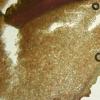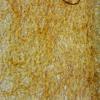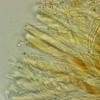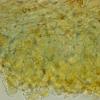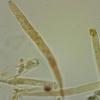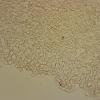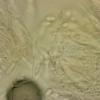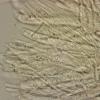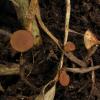
02-06-2013 13:13
Carmen EchavarriHello, this is the first time I participate in the

02-06-2013 15:22
 Jakob Schneller
Jakob Schneller
Recently I have found this pyrenomycetous fungus

02-06-2013 13:36
 Edouard Evangelisti
Edouard Evangelisti
Bonjour à tous, Je sollicite votre aide précieu

03-06-2013 19:10
Esquivel-Rios EduardoHola Todos.Saludos.Este especimen fue encontrado s

26-05-2013 22:11
Esquivel-Rios EduardoHola todos.Hace poco encontre esta xylariaceae en
Ciboria
Gilles Corriol,
26-04-2013 11:18
 Bonjour,
Bonjour,Voici un Ciboria récolté sur débris herbacés (apparemment plusieurs espèces d'après l'indument des restes, peut-être notamment Tamus communis) GC 13042105
Apothécie discoïde, jusque 7 mm, à pied court et épais. Hyménium brun roussâtre, hygrophane ; excipulum ectal blanchâtre. Pas de sclérote dans le substrat et stroma très discret si présent.
Spores 8,6-12,7 x 4,3-4,9 µm (eau), ellipsoïdes, lisses, hyalines, à deux gouttes polaires.
Asques 95-115 x 6,5-8 µm, I+ (lugol), bouclées.
Paraphyses étroitement cylindriques, septées.
Excipulum ectal à textura gobulosa, amyloïde. Trame à textura intricata, non amyloïde.
J'arrive vers C. latipes qui est sensée pousser sur une plante boréale non présente en France (Rubus chamaemorus).
Merci d'avance pour votre aide.
Hans-Otto Baral,
26-04-2013 11:22

Re : Ciboria
Hi Gilles
I would at first compare the genus Moellerodiscus. The living paraphyses do not contain VBs, however, which are typical of M. lentus.
Zotto
I would at first compare the genus Moellerodiscus. The living paraphyses do not contain VBs, however, which are typical of M. lentus.
Zotto
Gilles Corriol,
26-04-2013 12:03

Re : Ciboria
Thank you Zotto. Quick reply !
Sorry but what is VBs ?
Sorry but what is VBs ?
Hans-Otto Baral,
26-04-2013 12:07

Re : Ciboria
refractive vacuoles (similar as in Mollisia), occupying most space of the terminal cell of the paraphyses.
Raúl Tena Lahoz,
26-04-2013 13:14

Re : Ciboria
Hi Gilles
If possible, I´m interested in knowing if you got the blue reaction of the ectal excipulum directly when applying IKI or if you obtained it afted KOH pre-treatment.
Merci!
Raúl
If possible, I´m interested in knowing if you got the blue reaction of the ectal excipulum directly when applying IKI or if you obtained it afted KOH pre-treatment.
Merci!
Raúl
Gilles Corriol,
26-04-2013 15:30

Re : Ciboria
Raúl?,
The excipulum ectal was blue directly in lugol, without KOH treatment.
The excipulum ectal was blue directly in lugol, without KOH treatment.
Raúl Tena Lahoz,
26-04-2013 16:35

Re : Ciboria
Ok, thanks. I never seen a blue reaction of the excipular cells when adding IKI for Moellerodiscus lentus aggregate. But I have seen a pink reaction which turns blue if you pretreat with KOH and add again IKI (hemiamyloid). It is difficult to say where is the difference between Ciboria and Moellerodiscus. A lot of work to do in this group...
Amitiés,
Raúl
Amitiés,
Raúl
Hans-Otto Baral,
26-04-2013 18:04

Re : Ciboria
Now I see the macro (it was not there this morning), and I think I know:
Pycnopeziza sejournei. The very fleshy medulla and the directly blue IKI reaction would fit.
The species might be typical on Hedera but is obviously not specific. But could it be Hedera in your case?
Zotto
Pycnopeziza sejournei. The very fleshy medulla and the directly blue IKI reaction would fit.
The species might be typical on Hedera but is obviously not specific. But could it be Hedera in your case?
Zotto
Gilles Corriol,
27-04-2013 10:07

Re : Ciboria
Yes ! definitely, at least one of the branchlets is Hedera helix, with typical covering of stellate prostrate hairs.
May be also other subtrates without these hairs (Tamus communis ? Lonicera periclymenum ?) or also Hedera whose hairs are gone away ?
Thanks Zotto !
Gilles
May be also other subtrates without these hairs (Tamus communis ? Lonicera periclymenum ?) or also Hedera whose hairs are gone away ?
Thanks Zotto !
Gilles
Hans-Otto Baral,
27-04-2013 10:18

Re : Ciboria
I know a collection on Fraxinus leaf vein, and the two on Crataegus fruits on the DVD. Whether they are really conspecific I cannot say for sure, but they are very similar.
Zotto
Zotto
Raúl Tena Lahoz,
27-04-2013 18:02

Re : Ciboria
Ok, mystery solved. I wasn´t aware about this reaction in Pycnopeziza sejournei, I never collected it :-( In the only Pycnopeziza I have found (P. pachyderma) I haven´t noticed any reaction of excipular cells in IKI. And I don´t understand why Whetzel & White placed it in Pycnopeziza without having a related Acarosporium anamorph. I think Pycnopeziza sejournei should be returned to Ciboria, or maybe to Phaeociboria if genetically different?
Raúl
Raúl
Hans-Otto Baral,
27-04-2013 18:13

Re : Ciboria
yes, Raul, I agree, and I also don't know the arguments, but admit I have not read. But the limits of Ciboria are very difficult to draw. I am not sure whether Sclerotinia and Ciboria are really different enough, maybe the anamorph is so similar that only the sclerotium remains for distinction. The bigger oil drops in P. sejournei remind me also of my undescribed species on Veronica seeds, a paper on which is waiting since years though almost finished, and for which I tentatively use the genus Ciboria, but am not really happy with it. Not even the genetic analysis helped very much in this point.
Zotto
Zotto

